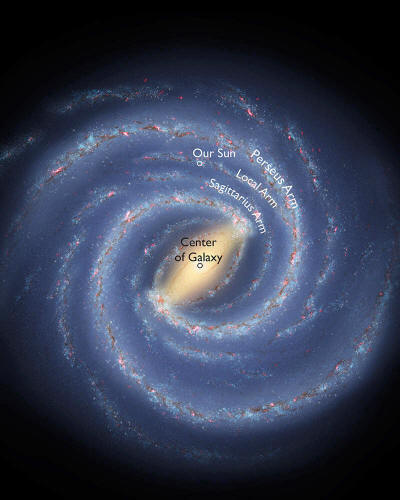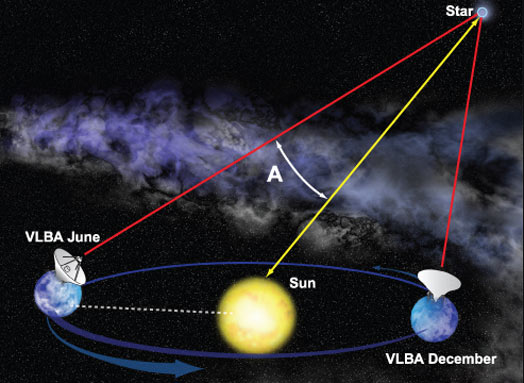|

June 3, 2013
from
ScienceDaily Website

New picture:
Local Arm probable major branch of Perseus Arm.
(Credit: Robert Hurt,
IPAC; Bill Saxton, NRAO/AUI/NSF)
Our Solar System's Milky Way neighborhood just went upscale. We
reside between two major spiral arms of our home galaxy, in a
structure called the
Local Arm.
New research using the ultra-sharp radio
vision of the National Science Foundation's Very Long Baseline
Array (VLBA)
indicates that the Local Arm, previously thought to be only a small
spur, instead is much more like the adjacent major arms, and is
likely a significant branch of one of them.
"Our new evidence suggests that the
Local Arm should appear as a prominent feature of the Milky
Way," said Alberto Sanna, of the Max-Planck Institute for Radio
Astronomy.
Alberto Sanna and his colleagues
presented their findings to the American Astronomical Society's
meeting in Indianapolis, Indiana.
Determining the structure of our own Galaxy has been a longstanding
problem for astronomers because we are inside it. In order to map
the Milky Way, scientists need to accurately measure the distances
to objects within the Galaxy.
Measuring cosmic distances, however,
also has been a difficult task, leading to large uncertainties. The
result is that, while astronomers agree that our Galaxy has a spiral
structure, there are disagreements on how many arms it has and on
their specific locations.
To help resolve this problem, researchers turned to the VLBA and its
ability to make the most accurate measurements of positions in the
sky available to astronomers.
The VLBA's capabilities allowed the
astronomers to use a technique that yields accurate distance
measurements unambiguously through simple trigonometry.

By observing objects when Earth is on opposite sides of its orbit
around the Sun, astronomers can measure the subtle shift in the
object's apparent position in the sky, compared to the background of
more-distant objects.
This effect is called parallax, and can
be demonstrated by holding your finger close to your nose and
alternately closing each eye.
The VLBA's ability to precisely measure very tiny shifts in apparent
position allows scientists to use this trigonometric method to
directly determine distances much farther from Earth than previously
was possible.
The astronomers used this method to measure the distances to
star-forming regions in the Milky Way where water and methanol
molecules are boosting radio waves in the same fashion that a laser
boosts light waves. These objects, called masers, are like
lighthouses for the radio telescopes.
The VLBA observations, carried out from
2008 to 2012, produced accurate distance measurements to the masers
and also allowed the scientists to track their motion through space.
A striking result was an upgrade to the status of the Local Arm
within which our Solar System resides.
We are between two major spiral arms of
the Galaxy, the
Sagittarius Arm and the
Perseus Arm. The Sagittarius Arm is closer to the Galactic
center and the Perseus Arm is farther out in the Galaxy. The Local
Arm previously was thought to be a minor structure, a "spur" between
the two longer arms.
Details of this finding were published
in the Astrophysical Journal by Xu Ye and collaborators.
"Based on both the distances and the
space motions we measured, our Local Arm is not a spur. It is a
major structure, maybe a branch of the Perseus Arm, or possibly
an independent arm segment," Sanna said.
The scientists also presented new
details about the distribution of star formation in the Perseus Arm,
and about the more-distant Outer Arm, which encompasses a warp in
our Galaxy.
The new observations are part of an ongoing project called the
Bar and Spiral Structure Legacy
(BeSSeL) survey, a major effort to map the Milky Way using the VLBA.
The acronym honors Friedrich Wilhelm Bessel, the German
astronomer who made the first accurate measurement of a star's
parallax in 1838.
The VLBA, dedicated in 1993, uses ten, 25-meter-diameter dish
antennas distributed from Hawaii to St. Croix in the Caribbean. It
is operated from the NRAO's Domenici Science Operations Center
in Socorro, NM. All ten antennas work together as a single telescope
with the greatest resolving power available to astronomy.
This unique capability has produced
landmark contributions to numerous scientific fields, ranging from,
-
Earth tectonics
-
climate research
-
spacecraft navigation
-
cosmology
The National Radio Astronomy Observatory
is a facility of the National Science Foundation, operated under
cooperative agreement by Associated Universities, Inc.
|


